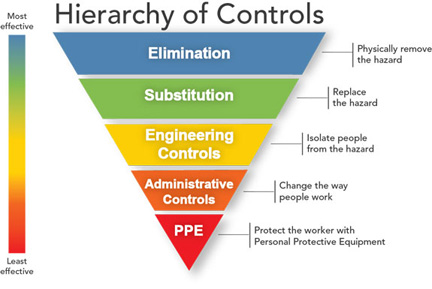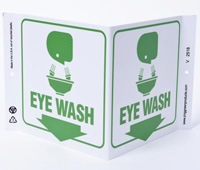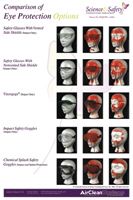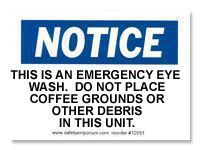



Find all of your laboratory and workplace safety supplies at Safety Emporium!
 Explosive |
 Glossary Index |
 Fetotoxin |
| MSDS Topics |
Free Sites | FAQ's | Regulations | Glossary | Software | Suppliers |
| Books | Forum | Poll | Fun stuff | Quiz | Store | |
| Understand your MSDS with the MS-Demystifier | Search ALL our MSDS info | |||||

Get your PPE such as NIOSH-approved N99 masks and face shields from Safety Emporium.
Emergency eye wash equipment is used to drench or flush the eyes with water when dust, irritants, or chemicals enter the eye. The term is sometimes written as one word, eyewash. These devices are sometimes referred to as "eye wash fountains".
Per 29 CFR, OSHA has numerous standards that require eye and face protection, including personal protective equipment such as safety glasses/goggles in addition to emergency eye wash facilities.
Emergency equipment such as eye washes is the final line of defense against eye hazards. The preferred sequence for reducing risk of injury in the workplace is:

Note that this approach is a multi-layer defense. By addressing each of these areas, one can minimize risks at many levels and hopefully never reach the last line of defense, emergency equipment.
29 CFR 1910.151 has the broadest requirement for eye washes and related equipment. At 1910.151(c) the Standard says:
Where the eyes or body of any person may be exposed to injurious corrosive materials, suitable facilities for quick drenching or flushing of the eyes and body shall be provided within the work area for immediate emergency use.
There is no specific discussion of what a "suitable facility" is in this, or any other, OSHA standard that discusses eye washes. While this permits the employer to select the equipment which is best suited to their particular workplace, it does not take account into best practices as found in ANSI Z358.1 (see below).
Therefore, OSHA inspectors (and most insurance carriers) look to the ANSI standard, Z358.1, "Emergency Eyewash and Shower Equipment" in determining the adequacy of eye wash facilities. Z358.1 addresses key areas in the design, deployment and use of emergency eye wash and safety shower equipment:

Safety Emporium carries all sorts of eye wash accessories such as eye wash signs, inspection tags, floor markers and replacement parts.
More detailed information about these ANSI requirements, including the required features and dimensions of eye wash and shower devices, can be found in Guardian Equipment's pamphlet, ANSI Z358.1-2014 Compliance Checklist.
Eye washes come in many different types/styles:
| Type | Comments | SE Part # |
|---|---|---|
| Eye wash bottles | Not ANSI-compliant because of the extremely limited amount of water. Generally useful as a secondary (personal) eye wash only in work areas that do not have an eyewash requirement under OSHA regulations. Home workshops User-refillable bottles must be filled with a saline solution or one that contains a bacteriostatic agent to prevent the growth of bacteria, fungus, algae, and acanthamoeba. Water should be changed every six months whether used or not. Other units come with a hermetically sealed bottle. Once opened, the bottle must be replaced. While portable, the bottles are prone to freezing and will be of little use on an unheated construction site, for example. Suppliers will not generally ship these units during periods of extremely cold weather, so getting a replacement quickly can sometimes be difficult. |
04036 (station) 04038 (Eye |
| Faucet-mounted | Not ANSI-compliant because it requires two motions to activate (turn on faucet, turn on water diverter) and because of the potential for scalding. Generally useful as a secondary (personal) eye wash only in work areas that do not have an eyewash requirement under OSHA regulations. The compact style saves space and does not require additional plumbing or drains. Able to deliver water for an indefinite period. |
G1100 (standard faucet) G1200 (gooseneck style faucets) |
| Portable Gravity-Fed | These units are filled with 16 gallons of water which drains out when the unit is activated. These units are ANSI-compliant as they can deliver 0.7 GPM for 15 minutes. A drain hose allows discharge to a drain where desired. These units are portable when empty, but are a bit unwieldly once filled (the filled weight is 145 lb (66 kg). They can be wall-mounted or table-mounted and do not require any plumbing. Must be filled with a saline solution or one that contains a bacteriostatic agent to prevent the growth of bacteria, fungus, algae, and acanthamoeba. Water should be changed every six months whether used or not. While portable, the unit can be prone to freezing on unheated job sites. Both insulated jackets as well as thermostatically heated covers are available for such situations; the latter requires a power supply. |
G1540 (eye wash) G1540BA-R (Aquasep preserv |
| Portable Pressure-Fed | These units are filled with 10 or 15 gallons of water and then pressurized with compressed air for water delivery. These units are ANSI-compliant as they can deliver 0.7 GPM for 15 minutes. The units shown here have a drench hose which can be used to flush other parts of the body. These units are portable although they may require a hand truck or cart to move when filled. No plumbing is required. Must be filled with a saline solution or one that contains bacteriostatic agent to prevent the growth of bacteria, fungus, algae, and acanthamoeba. Water should be changed every six months whether used or not. While portable, the unit can be prone to freezing on unheated job sites. Thermostatically heated covers are available for such situations, however this requires an electrical power source. |
G1562 (15 gallon) G1540BA-R (Aquasep preser |
| Eye wash/drench hose units | When permanently connected to a potable water source, these units are ANSI-compliant. They can be plumbed and permanently mounted on a wall or countertop or they can be connected with a garden hose adapter and used on job sites. They double as drench hoses which can be used to flush other parts of the body The minimal size takes up less space and costs slightly less than a dedicated plumbed eye wash. There is no drain, so the water discharged will end up on the floor. |
G5026 (wall mounted) G5022 (deck mounted) G6020 (tempering unit) |
| Wall-Mounted | These units are mounted to a wall and are ANSI-compliant. They can be plumbed to a drain (recommended). Also available as eye/
These units are not portable, so choose your installation site carefully. It must be located near the eye hazard area and can not be obstructed by equipment, boxes, bikes or other such items at any time. A tempering unit is suggested on any plumbed installation like this. Available in orange, green, and yellow ABS plastic or stainless steel. Also available with a bowl cover to keep people from dumping coffee grounds etc. into the bowl, foot controls, a flow alarm, and/or an auxilliary drench hose. |
G1814P (ABS orange) G1814 (stainless) G6020 (tempering unit) |
| Pedestal-Mounted | These ANSI-compliant units are free-standing so they do not require a sink or wall. These units are not portable, so choose your installation site carefully. It must be located near the eye hazard area and can not be obstructed by equipment, boxes, bikes or other such items at any time. A tempering unit is suggested on any plumbed installation like this. Also available with a bowl cover to keep people from dumping coffee grounds etc. into the bowl, foot controls (shown), a flow alarm, and/or an auxilliary drench hose. |
G1825 (stainless bowl) GFR1825 (freeze-protected) G6020 (tempering unit) |
| Sink-Mounted | These ANSI-compliant plumbed units utilize an existing sink to handle drainage and conserve space. The unit shown here stores to the side of the sink and is automatically activated when it is swung out. Similar units can swing down from the wall. A tempering unit is suggested on any plumbed installation like this. |
G1805 (deck swing) G1848 (wall swing) G6020 (tempering unit) |
| Safety Station | These ANSI-compliant units incorporate a safety shower, eye wash and an optional drench hose into one unit. Each component can be activated individuality. These units are not portable, so choose your installation site carefully. It must be located near the eye hazard area and can not be obstructed by equipment, boxes, bikes or other such items at any time. A tempering unit is suggested on any plumbed installation like this. Certain models can meet ADA requirements provided the shower head and pull rods are specially lengthened and the eyewash bowl is lowered to provide easy wheelchair access. |
G1902 (safety station) G1909 (safety station with eye/ G6040 (tempering unit) |
| Recessed | Recessed units provide an attractive and space-saving design by retracting into the wall when not in use. The one shown here is recessed into the wall and has a pull lever that deploys and activates the eye wash. These ANSI-compliant units meet ADA requirements for accessibility to wheelchairs and are recommended on any new construction. Several different styles are available with differing activation methods. These units are not portable, so choose your installation site carefully. It must be located near the eye hazard area and can not be obstructed by equipment, boxes, bikes or other such items at any time. Appropriate floor marking is suggested to mark the ara that must remain clear. A tempering unit is suggested on any plumbed installation like this. |
GBF1735DP (recess mount) GBF1724 (wall mount) G6020 (tempering unit) |

This safety wall poster graphically illustrates the shortcomings of most safety eyewear.
Just about every Safety Data Sheet in existence includes instructions to flush the eyes with water for "at least" 15 minutes if the material gets into one's eyes. The origin of the "15 minute rule" is not clear. In a few rare cases, such as a splash involving hydrofluoric acid, it may unacceptably delay first aid treatment, and in cases involving bases, a longer time may be required (bases are very difficult to rinse out of eye tissues). And some experts suggest even 15 minutes is not sufficient in most cases. In any event, should you get (or suspect you got) a chemical in your eye, be sure to flush it with water for the time recommended on the SDS or label and contact your doctor or emergency room to see if further treatment is needed.
If you were wearing contact lenses at the time of the incident, proper use of your eye wash should have washed them away, but have someone examine your eyes to verify that they were removed. NIOSH has a a "Current Intelligence Bulletin 59" titled "Contact Lens Use In a Chemical Environment" that addresses best practices for this formerly controversial topic.
When flushing the eyes, do your best to keep them open and be sure to occasionally lift the upper and lower eyelids to ensure complete flushing.
As noted above, the use of a tempering unit (thermostatic mixing valve) to deliver tepid water is generally recommended. Imagine trying to flush your eyes with the water that comes out of the cold water faucet in wintertime. Not only is it unbearable, the coldness of the water may cause the victim to end the flushing before it has been fully effective!
Finally, when selecting eye protection, be sure to wear the kind that is most appropriate. Chemical splash goggles offer the best protection against impact and liquid splashes as graphically illustrated on the poster shown on the left.

This sign as well as other eyewash and safety shower signs, tags, and more are available at Safety Emporium.
See also: conjunctivitis, iridocyclitis, nystagmus, sclera.
Additional definitions from Google and OneLook.
Entry last updated: Sunday, July 24, 2022. This page is copyright 2000-2025 by ILPI. Unauthorized duplication or posting on other web sites is expressly prohibited. Send suggestions, comments, and new entry desires (include the URL if applicable) to us by email.
Disclaimer: The information contained herein is believed to be true and accurate, however ILPI makes no guarantees concerning the veracity of any statement. Use of any information on this page is at the reader's own risk. ILPI strongly encourages the reader to consult the appropriate local, state and federal agencies concerning the matters discussed herein.